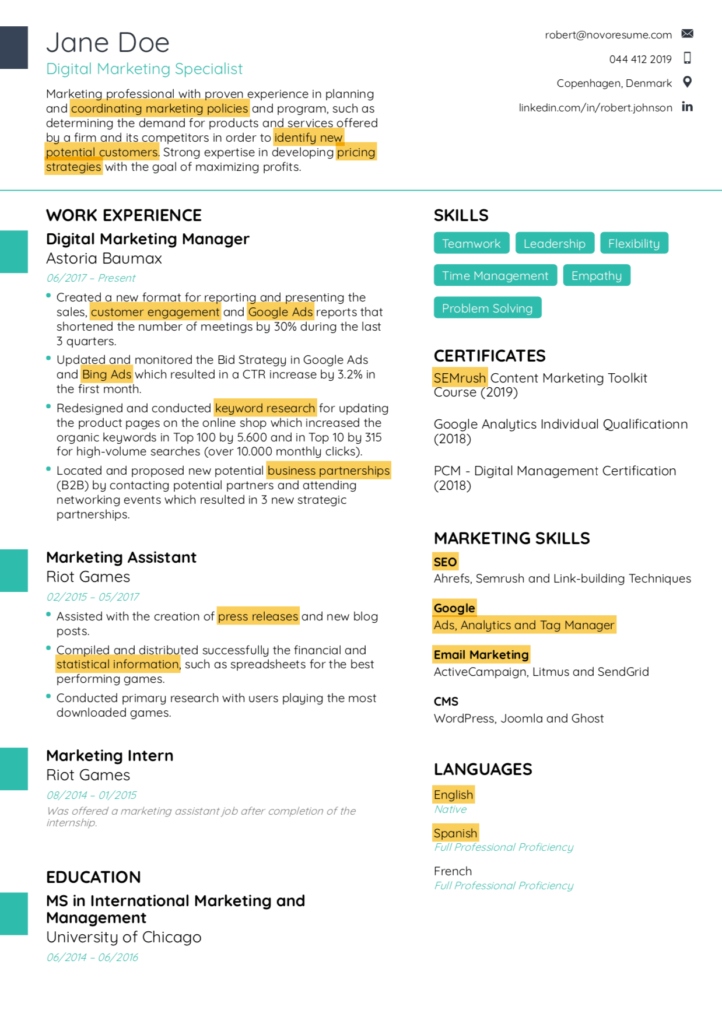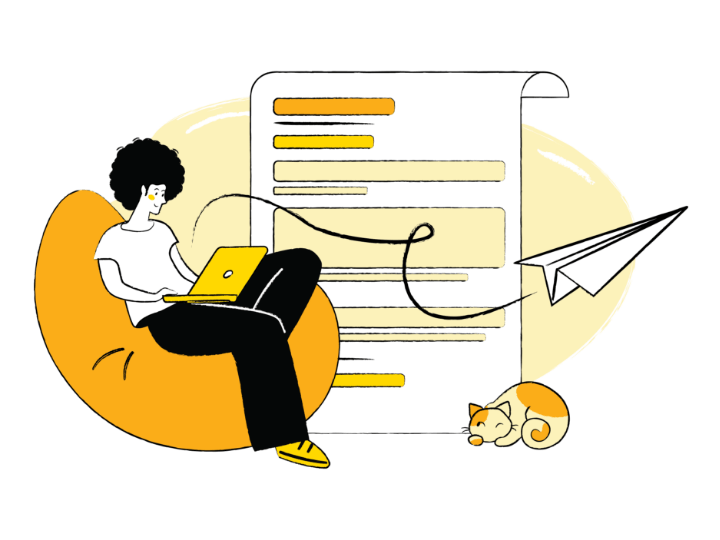Key Takeaways
- Strategic Keyword Integration: Learn to identify and incorporate targeted keywords from job descriptions, optimizing your resume for applicant tracking systems (ATS) and increasing visibility.
- Quantify Achievements for Impact: Discover the art of quantifying accomplishments to showcase tangible contributions, making your resume more compelling and capturing the attention of recruiters.
- Visual Appeal and Design Precision: Understand the importance of visual elements in resumes, strategically using fonts, white space, and formatting to create a visually appealing document that stands out in a competitive job market.
In today’s competitive job market, standing out from the crowd is crucial.
One of the most effective ways to catch the attention of hiring managers and recruiters is by tailoring your resume to the specific job descriptions you’re applying for.
Tailoring your resume demonstrates your understanding of the role and how your skills and experiences align with the employer’s needs.
In this comprehensive guide, we’ll delve deep into the strategies and techniques you need to know to tailor your resume effectively for specific job descriptions.
From understanding the intricacies of job postings to highlighting your achievements and skills, we’ll cover every aspect to ensure your resume shines bright in the eyes of prospective employers.

The Importance of Understanding Job Descriptions
Before you even begin crafting your resume, it’s crucial to thoroughly understand the job descriptions of the roles you’re interested in.
Job descriptions provide invaluable insights into the skills, qualifications, and experiences that employers are seeking in candidates.
By dissecting job descriptions, you can identify keywords, key responsibilities, and preferred qualifications, which will serve as the blueprint for tailoring your resume.
Understanding the nuances of job descriptions allows you to customize your resume to match the specific requirements of each role, increasing your chances of getting noticed by hiring managers.
Analyzing Your Skills and Experiences
Once you’ve gained a comprehensive understanding of the job descriptions, the next step is to analyze your own skills, experiences, and achievements.
Take stock of your professional background, education, certifications, and any relevant experiences that align with the job requirements.
Conduct a thorough self-assessment to identify your strengths and areas for improvement.
By aligning your skills and experiences with the job descriptions, you can effectively tailor your resume to showcase your qualifications and suitability for the role, making a compelling case for why you’re the perfect fit for the position.
Understanding the Company Culture and Values
In addition to aligning your skills with the job requirements, it’s also essential to consider the company culture and values when tailoring your resume.
Many employers prioritize cultural fit when evaluating candidates, so demonstrating your alignment with the company’s values can give you a competitive edge.
Look for cues in the job descriptions that reflect the company’s culture, such as keywords related to teamwork, innovation, or customer service.
Incorporating these elements into your resume can help you convey your fit with the company culture and increase your chances of securing an interview invitation.
Before we venture further into this article, we like to share who we are and what we do.
About UrbanCV
UrbanCV is a business tech startup based in Singapore, with a strong presence all over the world.
With over six years of recruiting, and hiring and being one of the top leaders in the HR industry, plus being highly involved in helping millions of job seekers find their dream jobs and internships, the UrbanCV team has listed some important learning points in this overview of the guide on How to Tailor Your Resume for Specific Job Descriptions.
If you are looking for a high-salaried job or an exciting internship, then try our partner job portal at 9cv9, which is the world’s leading job portal and HRtech company.
How to Tailor Your Resume for Specific Job Descriptions?
- Understanding the Job Description
- Analyzing Your Own Skills and Experience
- Customizing Resume Sections
- Incorporating Keywords
- Showcasing Achievements
- Formatting and Design Tips
- Tailoring Cover Letters
- Seeking Feedback
1. Understanding the Job Description

Unlocking Keywords and Phrases: The Building Blocks of Tailoring
Why it Matters: 99% of Fortune 500 companies and a growing number of small and mid-sized businesses filter resumes through an applicant tracking system (ATS).
These systems scan for specific keywords and phrases mentioned in job descriptions to shortlist candidates.
Example: Consider a marketing role that emphasizes “SEO optimization” and “content creation.”
Incorporating these exact terms into your resume can significantly increase your chances of passing through ATS scans and reaching the hands of human recruiters.
Identifying Key Skills and Qualifications: Precision in Customization
Example: If a job description highlights proficiency in project management software, such as “PMP certification” or “Agile methodologies,” tailoring your resume to showcase your experience with these tools can demonstrate your immediate suitability for the role.
Recognizing Cultural Fit Cues: Beyond Skills and Qualifications
Example: Suppose a job description emphasizes a “collaborative and innovative environment.”
In this case, incorporating experiences where you successfully collaborated on cross-functional projects or contributed to innovative solutions can enhance your appeal as a culturally aligned candidate.
Addressing Implicit Requirements: Reading Between the Lines
Often, job descriptions contain implicit requirements that are not explicitly stated.
For instance, phrases like “attention to detail” or “ability to multitask” may indicate the need for candidates with strong organizational skills.
Example: If a job description emphasizes the need for “meticulous attention to detail,” consider showcasing achievements where your attention to detail resulted in error-free project execution or enhanced operational efficiency.
Utilizing Industry-Specific Language: Speaking the Employer’s Language
Example: For a technology-focused position, incorporating industry-specific terms and acronyms relevant to the job, such as “cloud computing” or “API integration,” can demonstrate your familiarity with the field and catch the attention of tech-savvy recruiters.
2. Analyzing Your Own Skills and Experience

Embracing Your Professional Identity
Discovering and embracing your professional identity is the foundational step in analyzing your skills and experiences.
This involves a deep reflection on your strengths, values, and unique attributes that define your career persona.
Example: Consider a scenario where a candidate reflects on their communication skills, realizing they excel in conveying complex ideas to diverse audiences.
This self-awareness becomes a cornerstone for tailoring resumes for roles that prioritize effective communication.
Skill Assessment and Alignment
Identifying and assessing your skills is not merely a checklist exercise but a strategic effort to align your strengths with industry demands.
Tools like self-assessment quizzes and skills matrices can aid in quantifying and prioritizing your skillset.
Quantifying Achievements and Impact
In a competitive job market, quantifying your achievements adds credibility and depth to your resume.
Numerical data, such as percentages of revenue growth, project completion times, or customer satisfaction scores, substantiates your professional impact.
Example: Rather than stating “Managed a project successfully,” quantify the achievement by stating “Led a project team resulting in a 20% improvement in project completion time, exceeding client expectations.”
Showcasing Transferable Skills
Demonstrating transferable skills is key to showcasing your adaptability and versatility. These skills, which transcend specific roles, broaden your appeal to diverse employers.
Addressing Skill Gaps
Acknowledging and addressing skill gaps proactively demonstrates your commitment to continuous improvement. This can be achieved through courses, certifications, or hands-on experiences that enhance your skillset.
Example: A candidate seeking a transition into digital marketing might address a skill gap by obtaining a certification in social media marketing, showcasing their commitment to staying current in the industry.
Tailoring for Relevance
The heart of analyzing your skills and experiences lies in the art of tailoring. Each job application demands a bespoke resume that speaks directly to the needs of the employer.
Aligning your skills with the specific requirements of the job positions you as the perfect match.
61% of hiring managers say a customized resume will improve job chances.
The Power of Language
Crafting compelling language is an art that cannot be overstated. Utilizing action verbs, industry-relevant buzzwords, and strategic language throughout your resume amplifies the impact of your skills and experiences.
Example: Instead of saying “Responsible for managing a team,” opt for “Led a cross-functional team, resulting in a 15% increase in project efficiency.”
Embracing Feedback for Growth
Seeking feedback from mentors, peers, or professional resume services provides valuable perspectives that refine your self-analysis process. Constructive criticism serves as a catalyst for growth and improvement.
3. Customizing Resume Sections
Crafting a compelling resume goes beyond mere documentation; it’s an art form that involves strategic customization of various sections.
In this extensive exploration of resume customization, we’ll unravel the intricacies of tailoring each section for maximum impact, drawing insights from industry trends, data, and effective examples.

The Role of a Persuasive Summary or Objective
The resume summary or objective acts as the initial handshake with potential employers, offering a snapshot of your professional identity. Customizing this section involves tailoring it to align with the specific job and industry.
Example: For a marketing position, a tailored summary might read, “Results-oriented marketing professional with a proven track record of driving brand visibility and increasing customer engagement through innovative strategies.”
Strategic Showcase in the Skills Section
The skills section is not just a laundry list; it’s a strategic showcase of qualifications tailored to match the job description.
Incorporating relevant keywords and skills enhances visibility, especially in the age of applicant tracking systems (ATS).
Work Experience: Painting a Vivid Professional Picture
Customizing the work experience section involves selecting and emphasizing experiences that directly align with the job requirements. Quantifying achievements with numbers and metrics adds substance and credibility.
Example: Instead of stating “Managed projects,” quantify by saying, “Successfully led a project team, resulting in a 25% reduction in project completion time.”
Quantifying Achievements for Maximum Impact
Quantifying achievements transforms your resume from a list of responsibilities to a compelling narrative of tangible contributions. Numerical data substantiates your impact and catches the eye of recruiters.
Recruiters spend an average of 6 seconds reviewing a resume. Quantifying achievements ensures your impact is immediately apparent.
Education and Certifications as Foundations of Expertise
Tailoring the education and certifications section involves emphasizing relevant coursework, projects, or certifications that directly align with the requirements of the job.
This adds depth and credibility to your qualifications.
Example: For a tech role, highlight certifications like “AWS Certified Solutions Architect,” showcasing expertise in cloud computing.
Incorporating Extracurricular Activities for a Holistic View
While often underestimated, extracurricular activities can provide a holistic view of your personality and skills. Tailoring this section involves highlighting activities that showcase transferable skills.
Leveraging Additional Sections for Unique Value Proposition
The inclusion of additional sections, such as languages, publications, or volunteer work, presents an opportunity to unveil your unique value proposition.
Tailoring these sections involves selecting aspects that align with the job and showcase versatility.
Example: If applying for an international role, showcasing proficiency in multiple languages becomes a valuable addition.
Formatting and Design: Aesthetic Bridge to Professionalism
In the digital age, visual appeal is as crucial as content. Strategic formatting and design choices enhance readability and convey professionalism, ensuring your resume stands out in a competitive landscape.
Personalizing Cover Letters for a Comprehensive Approach
While not a section of the resume, tailoring cover letters complements the customization process. A personalized cover letter reinforces your alignment with the job and company culture.
Example: Addressing specific points from the job description in the cover letter demonstrates attention to detail and genuine interest.
4. Incorporating Keywords
In the ever-evolving landscape of job applications, incorporating keywords into your resume is akin to deploying a strategic SEO plan.
This section will delve into the significance of keywords, and their role in applicant tracking systems (ATS), and provide practical insights on how to seamlessly integrate them into your professional narrative.

The Crucial Role of Keywords in Resumes
Keywords are the linchpin of modern resume optimization, acting as gatekeepers that determine whether your resume makes it past initial screening.
These are specific terms, skills, or phrases directly relevant to the job description that showcase your suitability for the role.
Why Keywords Matter in ATS
Applicant tracking systems (ATS) are the first hurdle in the recruitment process.
These systems scan resumes for keywords to determine if the applicant’s qualifications align with the job requirements. Optimizing your resume with relevant keywords is crucial for bypassing ATS filters.
Example: If a job description emphasizes “project management skills” and “cross-functional collaboration,” incorporating these exact terms in your resume ensures compatibility with ATS scans.
Identifying Relevant Keywords in Job Descriptions
Strategic keyword incorporation begins with a meticulous analysis of job descriptions. Identify specific skills, qualifications, and industry jargon used in the job posting to tailor your resume accordingly.
Strategically Placing Keywords Throughout the Resume
The placement of keywords within your resume is as critical as their selection.
Distribute them strategically across various sections, including the summary, skills, work experience, and education, ensuring a natural flow that aligns with the narrative.
Example: For a software developer role requiring proficiency in “Java” and “Python,” mention these languages prominently in the skills section and incorporate them naturally in the work experience descriptions.
Tools and Techniques for Keyword Identification
Utilizing tools to identify relevant keywords is a savvy approach.
Jobscan, for instance, is a tool that analyzes your resume against the job description, providing a keyword match rate and valuable insights on optimizing your resume.
Industry-Specific Keywords and Their Impact
Different industries have specific keywords and terminology. Incorporating industry-specific language not only aligns your resume with the job but also signals your familiarity with the field.
Example: In the healthcare sector, terms like “HIPAA compliance” and “Electronic Health Records (EHR)” are industry-specific keywords that enhance your resume’s relevance.
Keyword Synonyms and Variations
To enhance your resume’s versatility, include synonyms and variations of keywords.
This ensures that even if different terms are used in job descriptions, your resume remains adaptable and responsive to diverse opportunities.
Dynamic Adjustment for Each Application
Tailoring your resume for each application involves dynamic adjustment of keywords. While maintaining consistency, adapt the emphasis on certain keywords based on the specific requirements of each job.
Example: If one job description prioritizes “data analysis,” while another emphasizes “statistical analysis,” adjust your resume accordingly to highlight the relevant expertise.
5. Showcasing Achievements
In the dynamic world of job applications, showcasing achievements on your resume is not just a nicety; it’s a strategic imperative that sets you apart from the competition.
This section will explore the significance of quantifiable accomplishments, and strategies for effective achievement presentation, and offer real-world examples to guide you in crafting an achievement-focused resume.

The Power of Quantifiable Achievements
Quantifying achievements on your resume adds a layer of authenticity and impact, providing tangible evidence of your contributions.
Numbers, percentages, and metrics substantiate your claims, making your resume more compelling.
Strategies for Effective Achievement Presentation
Crafting an achievement-focused resume involves strategic presentation. Utilize action verbs, highlight specific outcomes, and demonstrate how your contributions positively impacted the organization.
Example: Instead of stating “Led a project team,” articulate it as “Led a cross-functional project team, resulting in a 25% improvement in project completion time.”
Emphasizing Results and Impact in Previous Roles
Emphasizing results and impact showcases your ability to drive positive change. Demonstrate how your efforts led to increased efficiency, revenue growth, cost savings, or improved processes.
Example: “Implemented a streamlined communication strategy, resulting in a 15% increase in client satisfaction and a 20% reduction in response time.”
Aligning Achievements with the Employer’s Needs
Tailoring achievements to align with the specific needs of the employer is a strategic approach. Analyze the job description and emphasize accomplishments that directly correlate with the desired skills and outcomes.
Highlighting Leadership and Team Contributions
If you’ve held leadership roles, highlight achievements that showcase your leadership skills and impact on team performance. For team contributions, emphasize collaboration and successful project outcomes.
Example: “Led a cross-functional team to successfully launch a new product, resulting in a 30% increase in sales within the first quarter.”
Utilizing the PAR (Problem-Action-Result) Methodology
The PAR methodology structures achievements by presenting the problem or challenge, the actions taken, and the measurable results. This approach provides a clear narrative of your problem-solving abilities.
Example: “Identified inefficiencies in the supply chain, implemented process improvements, and achieved a 20% reduction in production costs.”
Demonstrating Innovation and Initiative
Showcasing achievements that highlight your innovation and initiative can be particularly appealing to employers. Illustrate instances where you took proactive steps to improve processes or introduce novel solutions.
Tailoring Achievements for Different Resume Sections
Customize the presentation of achievements across various resume sections, including the summary, skills, and work experience. Ensure consistency and relevance to maximize their impact.
Example: In the skills section, mention achievements related to specific competencies, such as “Increased social media engagement by 40% through targeted campaigns.”
6. Formatting and Design Tips
In the digital age, the visual appeal of your resume is as crucial as its content.
This section will explore the importance of effective formatting and design.

The Significance of Visually Appealing Resumes
In a sea of digital applications, a visually appealing resume can be a game-changer.
Recruiters often form initial impressions within seconds, making a well-designed resume more likely to capture attention and convey professionalism.
Strategic Font Selection for Readability
Choosing the right font contributes to readability and visual harmony. Opt for clean, sans-serif fonts like Arial or Calibri, maintaining a font size between 10-12 points for optimal readability.
Example: A well-chosen font ensures that your resume is professional and easy to read, enhancing the overall visual impression.
Utilizing White Space for Visual Clarity
White space, or negative space, is the unmarked area between elements. Strategic use of white space enhances visual clarity, preventing your resume from appearing cluttered and overwhelming.
Consistent Formatting for a Polished Look
Maintain consistency in formatting throughout your resume. Ensure uniformity in font styles, bullet points, and headings. Consistent formatting creates a polished and professional aesthetic.
Example: If you use bold for job titles in one section, maintain the same formatting across all job titles for a cohesive visual presentation.
Incorporating Bullet Points for Readability
Bullet points offer a structured and scannable format, aiding recruiters in quickly grasping key information. Use bullet points to succinctly present achievements, responsibilities, and skills.
Strategic Use of Colors for Emphasis
While a clean and minimalistic approach is often preferred, strategic use of color can draw attention to specific sections or elements. Choose a color palette that aligns with your industry and maintains a professional look.
Example: Using a subtle color for headings or accents can add visual interest without overshadowing the content.
Incorporating Relevant Icons or Graphics Sparingly
Incorporating icons or graphics can enhance visual appeal when used sparingly and appropriately. Icons can represent skills or highlight key sections, contributing to a modern and dynamic look.
Optimizing for Applicant Tracking Systems (ATS)
Ensure that your resume is ATS-friendly by avoiding complex designs or excessive formatting. ATS may struggle with intricate layouts, potentially hindering your resume from reaching human eyes.
Customizing Design for Your Industry
Tailor the design of your resume to match the conventions of your industry. Creative fields might allow for more visual elements, while traditional sectors may require a more conservative approach.
Example: A graphic designer’s resume can showcase creativity with unique layouts, while a finance professional may benefit from a clean and structured design.
Mobile Optimization for Accessibility
Given the prevalence of mobile job searches, ensure your resume is mobile-friendly. Use a simple design, check the readability on mobile devices, and avoid overly complex formatting.
7. Tailoring Cover Letters
A cover letter is not just a perfunctory document but a powerful tool that can set the stage for a successful job application.
This section will delve into the art of tailoring cover letters, providing actionable tips, real-world examples, and insights from industry studies to guide you in creating impactful and customized narratives.

Understanding the Importance of Tailoring Cover Letters
Tailoring cover letters is more than a courtesy; it’s a strategic approach to demonstrate your genuine interest in the position and showcase how your unique skills align with the company’s needs.
Researching the Company and Position
Before crafting a cover letter, conduct thorough research on the company and the specific job role. Understand the company’s values, goals, and the requirements of the position to align your narrative accordingly.
Example: If applying for a marketing role at a tech startup, research the company’s innovative projects and emphasize your experience in digital marketing and tech-savvy strategies.
Addressing the Hiring Manager by Name
Whenever possible, address the cover letter to the hiring manager by name. This personal touch shows that you’ve invested time in understanding the company’s structure and adds a level of direct engagement.
An eye-catching cover letter begins with a salutation that mentions the hiring manager’s name.
Customizing the Opening Paragraph
The opening paragraph should immediately capture the reader’s attention. Tailor it to reflect your enthusiasm for the company, the specific role, or a recent achievement of the organization.
Example: “Having closely followed XYZ Company’s groundbreaking initiatives, I am thrilled to apply for the [Position] role and contribute to your continued success.”
Aligning Skills and Experiences with Job Requirements
The body of the cover letter is an opportunity to align your skills and experiences with the requirements of the job.
Reference specific qualifications from the job description and illustrate how your background is a perfect match.
Showcasing Cultural Fit and Company Knowledge
Highlighting your understanding of the company’s culture and values contributes to showcasing a strong cultural fit. Share experiences or achievements that align with the company’s ethos.
Example: “I am drawn to ABC Company’s commitment to innovation, a value I resonate with deeply, as evidenced by my role in implementing cutting-edge solutions at my previous workplace.”
Quantifying Achievements and Impact
Quantifying achievements adds substance to your cover letter. Use metrics or percentages to illustrate the impact of your contributions in previous roles.
Concluding with a Strong Call to Action
End the cover letter with a strong call to action, expressing your eagerness for an interview and conveying appreciation for the opportunity to apply.
Example: “I am excited about the possibility of contributing to [Company] and would welcome the opportunity to discuss how my skills align with your team’s objectives in a personal interview.”
Editing and Proofreading for Precision
Thoroughly edit and proofread your cover letter to ensure accuracy and precision. Typos and grammatical errors can detract from the professionalism of your application.
Customizing for Different Job Applications
Recognize that each job application is unique and demands a tailored approach. Customizing your cover letter for different positions ensures relevance and increases your chances of standing out.
Example: While applying for a project management role, emphasize your experience in leading successful cross-functional projects. For a sales role, highlight your track record of exceeding revenue targets.
Utilizing Keywords Relevant to the Position
Incorporate keywords relevant to the job position, mirroring terms used in the job description. This not only shows alignment but also helps your cover letter pass through applicant tracking systems (ATS).
Seeking Feedback from Peers or Mentors
Before finalizing your cover letter, seek feedback from peers, mentors, or career advisors. External perspectives can offer valuable insights and identify areas for improvement.
Example: A peer might provide constructive feedback on the tone or suggest additional details that could strengthen your narrative.
A/B Testing for Optimization
Consider A/B testing different versions of your cover letter to identify which elements resonate better with employers. This iterative approach allows for continuous refinement and optimization.
A/B testing, commonly used in marketing, can be applied to job applications for iterative improvement. Platforms like VMock offer AI-driven resume and cover letter evaluations.
8. Seeking Feedback
Seeking feedback is not a sign of weakness but a proactive step towards continuous improvement.
This section will explore the importance of feedback in personal and professional development, provide practical strategies for seeking constructive input, and present real-world examples illustrating its transformative impact.

The Transformative Power of Constructive Feedback
Constructive feedback serves as a powerful catalyst for growth, offering valuable insights into strengths, areas for improvement, and blind spots. Embracing feedback fosters a culture of continuous learning and development.
Feedback as a Two-Way Street
Feedback is not a one-way process but a dynamic exchange. Both giving and receiving feedback are integral components of effective communication within professional relationships.
Example: If you’ve completed a project, seek feedback from team members, and reciprocate by providing constructive input on their endeavors.
Proactive Feedback Seeking for Career Advancement
Actively seeking feedback demonstrates initiative and a commitment to professional growth. By soliciting input from supervisors, peers, and mentors, you position yourself as someone dedicated to refining your skills.
Strategies for Soliciting Constructive Feedback
Effective feedback solicitation involves targeted strategies. Create opportunities for open communication, use specific questions, and ensure the feedback aligns with your professional goals.
Example: Instead of a generic request like “Do you have any feedback for me?” ask specific questions such as “How can I enhance my presentation skills for client meetings?”
Timing Matters: Strategic Feedback Requests
Timing plays a crucial role in feedback solicitation. Choose moments when the environment is conducive to constructive discussions, ensuring that both parties are focused and receptive.
Feedback from Diverse Perspectives for Holistic Insights
Diversify the sources of feedback to gain a comprehensive understanding of your strengths and areas for improvement. Seek input from colleagues, subordinates, and those outside your immediate team.
Example: If you’re a manager, gather feedback from team members, clients, and other departments to gain a holistic perspective on your leadership style.
Constructive Criticism vs. Positive Feedback: A Balanced Approach
Balance is key when seeking feedback. Embrace constructive criticism for areas of improvement, but also welcome positive feedback. Acknowledging strengths boosts morale and reinforces effective practices.
Feedback for Skill Development: Sharpening the Professional Toolbox
Use feedback as a tool for skill development. If feedback highlights a specific skill gap, proactively seek opportunities for training, mentorship, or self-directed learning.
Example: If feedback suggests a need for enhanced project management skills, enroll in a relevant course or seek guidance from a mentor experienced in project management.
Utilizing Feedback in Performance Reviews
Performance reviews are ideal occasions to gather structured feedback. Encourage open dialogue with supervisors, discuss career goals, and collaborate on a development plan based on the feedback received.
Feedback for Personal Branding: Shaping Professional Perception
Feedback contributes to the shaping of your personal brand. Positive feedback reinforces your strengths, while constructive feedback allows you to proactively address areas that may impact your professional image.
Example: If feedback consistently highlights your effective problem-solving skills, leverage this in your personal branding by showcasing your ability to navigate challenges.
Handling Feedback: The Art of Receptivity
Receiving feedback graciously is an art. Maintain an open mind, focus on the message rather than the delivery, and use feedback as a springboard for improvement.
Feedback in Job Searching: Refining Application Materials
When seeking a new job, use feedback to refine your application materials. Seek input on your resume, cover letter, and LinkedIn profile to ensure they effectively represent your skills and experiences.
Example: If feedback suggests a need for clearer quantification of achievements in your resume, revise your content to include specific metrics and outcomes.
Feedback in Team Dynamics: Fostering Collaboration
Within a team setting, feedback is integral to fostering collaboration. Regularly seek input from team members, provide constructive feedback to others, and collectively work towards improving team dynamics.
Leveraging Technology for Anonymous Feedback
In situations where anonymity fosters honesty, consider leveraging technology for anonymous feedback. Online surveys or platforms can provide candid insights that individuals might be hesitant to share openly.
Example: Anonymous feedback can be particularly useful in gathering insights on leadership style or team dynamics during periods of organizational change.
Feedback for Long-Term Career Planning: Charting the Trajectory
Beyond immediate skill refinement, use feedback to inform long-term career planning. Identify patterns in feedback that indicate areas for continuous development and strategize for future success.
Conclusion
In the intricate tapestry of job hunting, the ability to tailor your resume for specific job descriptions emerges as a skill that can redefine your professional trajectory.
As we navigate through the extensive exploration of this artful process, it becomes evident that precision is not just a virtue; it’s a strategic imperative that sets you apart in a competitive job market.
The Tailoring Paradigm: A Dynamic Approach to Resume Writing
Tailoring your resume is not a one-size-fits-all endeavor but a dynamic process that demands meticulous attention to detail.
From understanding the nuances of the job description to aligning your skills and experiences with precision, each step contributes to the creation of a resume that resonates with recruiters and hiring managers.
Quantifiable Impact: Numbers Speak Louder Than Words
As we unravel the significance of quantifiable achievements, the power of numbers becomes undeniable. Data points from various studies underscore the impact of metrics in capturing the attention of recruiters.
Navigating the ATS Maze: Keywords as the Guiding Constellations
In an era dominated by Applicant Tracking Systems (ATS), understanding the role of keywords becomes pivotal.
With an array of tools and techniques at your disposal, optimizing your resume for ATS screening is not just a technicality but a strategic move to ensure your document stands out in the initial screening process.
Crafting a Visual Symphony: The Harmony of Formatting and Design
The visual appeal of your resume is no longer an afterthought but a key determinant of its success.
The strategic use of fonts, white space, colors, and even icons transforms your resume from a mere document into a visual symphony that captures attention and communicates professionalism.
The Holistic Approach: Tailoring Cover Letters and Seeking Feedback
Beyond the confines of the resume, we explore the art of tailoring cover letters – personalized narratives that complement your professional story.
Addressing the hiring manager by name, aligning skills with job requirements, and utilizing keywords are all components of a cover letter that speaks directly to the heart of a prospective employer.
But the journey doesn’t end with the submission of application materials.
Seeking feedback emerges as the compass guiding your professional growth.
Constructive input, whether from supervisors, peers, or mentors, becomes the catalyst for refinement, ensuring that your skills evolve in tandem with the ever-changing demands of the professional landscape.
A Dynamic Reservoir of Skills: Analyzing Your Own Skills and Experience
Amidst this strategic journey, we delve into the process of analyzing your own skills and experiences.
Highlighting transferable skills, emphasizing industry-specific qualifications, and leveraging extracurricular activities provide a holistic view of your professional identity.
They also position you as a dynamic candidate equipped to navigate diverse challenges.
Customization as the Professional Signature
In the realm of customization, each section of your resume becomes a canvas for your professional signature.
Whether it’s the strategic showcase of skills, the vivid painting of your work experience, or the incorporation of additional sections, the customization process is akin to sculpting a masterpiece.
This is a document that not only reflects who you are but also resonates with the specific needs of the job you aspire to secure.
Embarking on a Tailored Future
As we conclude this exploration into the art of tailoring resumes for specific job descriptions, remember that the journey is not just about securing a job; it’s about crafting a future tailored to your aspirations.
Each strategic decision, from quantifying achievements to incorporating keywords and seeking feedback, becomes a stepping stone toward a tailored professional destiny.
May this comprehensive guide serve as your compass, guiding you through the intricate landscape of resume tailoring.
As you embark on the journey of customization, may your resume not only open doors to opportunities but also stand as a testament to your ability to adapt, evolve, and thrive in the ever-evolving world of careers.
Tailor your story, craft your narrative, and step confidently into a future shaped by your precision and professionalism.
If you find this article useful, why not share it with your friends and also leave a nice comment below?
We, at the UrbanCV Research Team, strive to bring the latest and most meaningful CV data, Resume guides, and CV statistics to your doorstep.
To get access to top-quality Resumes, CVs, and Cover Letter guides, click over to the UrbanCV Blog.
If you are keen to find your next job or internship, then click on 9cv9 Job Portal now.
People also ask
Should you tailor your resume to a specific position?
Absolutely. Tailoring your resume to a specific position is crucial. It demonstrates a clear alignment between your skills and the job requirements, making you stand out to recruiters. Customizing your resume increases the chances of getting noticed and landing the job you desire.
How specific should I be in the job description on my resume?
Be highly specific in your job descriptions on the resume. Use quantifiable achievements, relevant keywords, and tailor details to match the job you’re applying for. The more specific and tailored, the better your resume aligns with the employer’s needs, increasing your chances of success.
How do you write a resume with the same job description?
To write a compelling resume with the same job description, emphasize your unique achievements and experiences within that role. Use metrics to showcase your impact, incorporate relevant keywords, and focus on how your skills uniquely contribute to the specific needs of the position.
















